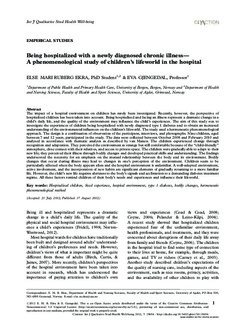| dc.contributor.author | Ekra, Else Mari Ruberg | |
| dc.contributor.author | Gjengedal, Eva | |
| dc.date.accessioned | 2012-08-30T12:42:34Z | |
| dc.date.available | 2012-08-30T12:42:34Z | |
| dc.date.issued | 2012 | |
| dc.identifier.citation | Ekra, E., & Gjengedal, E. (2012). Being hospitalized with a newly diagnosed chronic illness - A phenomenological study of children’s lifeworld in the hospital. International Journal Of Qualitative Studies On Health And Well-Being, 7. doi:10.3402/qhw.v7i0.18694 | no_NO |
| dc.identifier.issn | 1748-2631 | |
| dc.identifier.uri | http://hdl.handle.net/11250/138687 | |
| dc.description | Published version of an article in the journal: International Journal of Qualitative Studies on Health and Well-being. Also available from Co-Action Publishing: http://dx.doi.org/10.3402/qhw.v7i0.18694
Open Access | no_NO |
| dc.description.abstract | The impact of a hospital environment on children has rarely been investigated. Recently, however, the perspective of hospitalized children has been taken into account. Being hospitalized and facing an illness represent a dramatic change in a child’s daily life, and the quality of the environment may influence the child’s experiences. The aim of this study was to investigate the experiences of children being hospitalized with newly diagnosed type 1 diabetes and to obtain an increased understanding of the environmental influences on the children’s lifeworld. The study used a hermeneutic phenomenological approach. The design is a combination of observation of the participant, interviews, and photographs. Nine children, aged between 7 and 12 years, participated in the study. The data were collected between October 2008 and February 2010 and analysed in accordance with thematic analysis as described by van Manen. The children experienced change through recognition and adaptation. They perceived the environment as strange but still comfortable because of the ‘‘child-friendly’’ atmosphere, close contact with their relatives, and access to private space. The children were gradually able to adapt to their new life; they perceived their illness through bodily changes and developed practical skills and understanding. The findings underscored the necessity for an emphasis on the mutual relationship between the body and its environment. Bodily changes that occur during illness may lead to changes in one’s perception of the environment. Children seem to be particularly affected when the body appears alien and the hospital environment is unfamiliar. A well-adapted environment, active involvement, and the incorporation of new habits are significant elements of gradually returning to a more familiar life. However, the child’s new life requires alertness to the body’s signals and acclimation to a demanding diabetes treatment regime. All these factors remind children of their body’s needs and experiences and influence their lifeworld. | no_NO |
| dc.language.iso | eng | no_NO |
| dc.publisher | Co-Action Publishing | no_NO |
| dc.title | Being hospitalized with a newly diagnosed chronic illness - A phenomenological study of children’s lifeworld in the hospital | no_NO |
| dc.type | Journal article | no_NO |
| dc.type | Peer reviewed | no_NO |
| dc.subject.nsi | VDP::Medical disciplines: 700::Health sciences: 800::Nursing science: 808 | no_NO |
| dc.subject.nsi | VDP::Medical disciplines: 700::Clinical medical disciplines: 750::Pediatrics: 760 | no_NO |
| dc.source.pagenumber | 1-9 | no_NO |
| dc.source.volume | 7 | no_NO |
| dc.source.journal | Journal Of Qualitative Studies On Health And Well-Being | no_NO |
